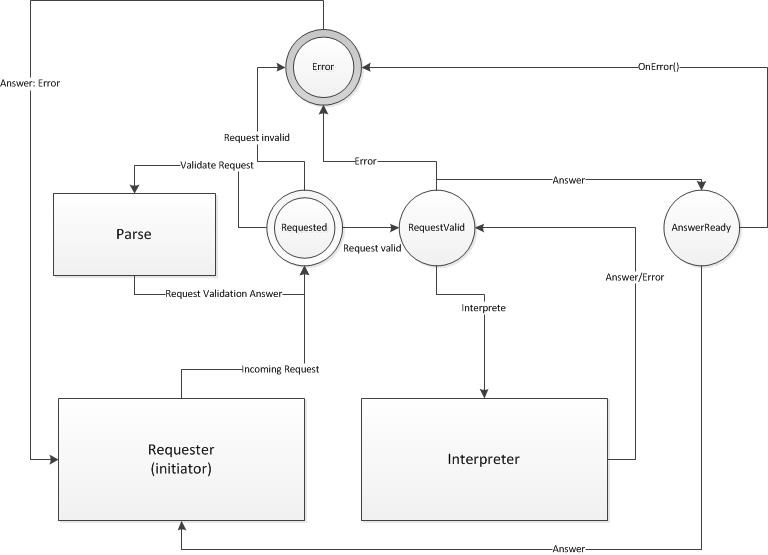I am trying to implement a simple example/demo for a state machine using Automatonymous with RabbitMQ. Unfortunately I could not find one to rebuild / learn from (I found the ShoppingWeb, but in my eyes it's anything but simple). Also in my opinion the documentation is lacking information.
This is the state machine example I thought of (sorry, it's pretty ugly):
 Please note that this example is completely made up and it's not important if it makes sense or not. This project's purpose is to get "warm" with Automatonymous.
Please note that this example is completely made up and it's not important if it makes sense or not. This project's purpose is to get "warm" with Automatonymous.
What I want to do / to have is:
- Four applications running:
- The state machine itself
- The "requester" sending requests to be interpreted
- The "validator" or "parser" checking if the provided request is valid
- The "interpreter" interpreting the given request
- An example of this could be:
- Requester sends "x=5"
- Validator checks if a "=" is contained
- Intepreter says "5"
My implementation of the state machine looks like this:
public class InterpreterStateMachine : MassTransitStateMachine<InterpreterInstance>
{
public InterpreterStateMachine()
{
InstanceState(x => x.CurrentState);
Event(() => Requesting, x => x.CorrelateBy(request => request.Request.RequestString, context => context.Message.Request.RequestString)
.SelectId(context => Guid.NewGuid()));
Event(() => Validating, x => x.CorrelateBy(request => request.Request.RequestString, context => context.Message.Request.RequestString));
Event(() => Interpreting, x => x.CorrelateBy(request => request.Request.RequestString, context => context.Message.Request.RequestString));
Initially(
When(Requesting)
.Then(context =>
{
context.Instance.Request = new Request(context.Data.Request.RequestString);
})
.ThenAsync(context => Console.Out.WriteLineAsync($"Request received: {context.Data.Request.RequestString}"))
.Publish(context => new ValidationNeededEvent(context.Instance))
.TransitionTo(Requested)
);
During(Requested,
When(Validating)
.Then(context =>
{
context.Instance.Request.IsValid = context.Data.Request.IsValid;
if (!context.Data.Request.IsValid)
{
this.TransitionToState(context.Instance, Error);
}
else
{
this.TransitionToState(context.Instance, RequestValid);
}
})
.ThenAsync(context => Console.Out.WriteLineAsync($"Request '{context.Data.Request.RequestString}' validated with {context.Instance.Request.IsValid}"))
.Publish(context => new InterpretationNeededEvent(context.Instance))
,
Ignore(Requesting),
Ignore(Interpreting)
);
During(RequestValid,
When(Interpreting)
.Then((context) =>
{
//do something
})
.ThenAsync(context => Console.Out.WriteLineAsync($"Request '{context.Data.Request.RequestString}' interpreted with {context.Data.Answer}"))
.Publish(context => new AnswerReadyEvent(context.Instance))
.TransitionTo(AnswerReady)
.Finalize(),
Ignore(Requesting),
Ignore(Validating)
);
SetCompletedWhenFinalized();
}
public State Requested { get; private set; }
public State RequestValid { get; private set; }
public State AnswerReady { get; private set; }
public State Error { get; private set; }
//Someone is sending a request to interprete
public Event<IRequesting> Requesting { get; private set; }
//Request is validated
public Event<IValidating> Validating { get; private set; }
//Request is interpreted
public Event<IInterpreting> Interpreting { get; private set; }
class ValidationNeededEvent : IValidationNeeded
{
readonly InterpreterInstance _instance;
public ValidationNeededEvent(InterpreterInstance instance)
{
_instance = instance;
}
public Guid RequestId => _instance.CorrelationId;
public Request Request => _instance.Request;
}
class InterpretationNeededEvent : IInterpretationNeeded
{
readonly InterpreterInstance _instance;
public InterpretationNeededEvent(InterpreterInstance instance)
{
_instance = instance;
}
public Guid RequestId => _instance.CorrelationId;
}
class AnswerReadyEvent : IAnswerReady
{
readonly InterpreterInstance _instance;
public AnswerReadyEvent(InterpreterInstance instance)
{
_instance = instance;
}
public Guid RequestId => _instance.CorrelationId;
}
}
Then I have services like this:
public class RequestService : ServiceControl
{
readonly IScheduler scheduler;
IBusControl busControl;
BusHandle busHandle;
InterpreterStateMachine machine;
InMemorySagaRepository<InterpreterInstance> repository;
public RequestService()
{
scheduler = CreateScheduler();
}
public bool Start(HostControl hostControl)
{
Console.WriteLine("Creating bus...");
machine = new InterpreterStateMachine();
repository = new InMemorySagaRepository<InterpreterInstance>();
busControl = Bus.Factory.CreateUsingRabbitMq(x =>
{
IRabbitMqHost host = x.Host(new Uri(/*rabbitMQ server*/), h =>
{
/*credentials*/
});
x.UseInMemoryScheduler();
x.ReceiveEndpoint(host, "interpreting_answer", e =>
{
e.PrefetchCount = 5; //?
e.StateMachineSaga(machine, repository);
});
x.ReceiveEndpoint(host, "2", e =>
{
e.PrefetchCount = 1;
x.UseMessageScheduler(e.InputAddress);
//Scheduling !?
e.Consumer(() => new ScheduleMessageConsumer(scheduler));
e.Consumer(() => new CancelScheduledMessageConsumer(scheduler));
});
});
Console.WriteLine("Starting bus...");
try
{
busHandle = MassTransit.Util.TaskUtil.Await<BusHandle>(() => busControl.StartAsync());
scheduler.JobFactory = new MassTransitJobFactory(busControl);
scheduler.Start();
}
catch (Exception)
{
scheduler.Shutdown();
throw;
}
return true;
}
public bool Stop(HostControl hostControl)
{
Console.WriteLine("Stopping bus...");
scheduler.Standby();
if (busHandle != null) busHandle.Stop();
scheduler.Shutdown();
return true;
}
static IScheduler CreateScheduler()
{
ISchedulerFactory schedulerFactory = new StdSchedulerFactory();
IScheduler scheduler = MassTransit.Util.TaskUtil.Await<IScheduler>(() => schedulerFactory.GetScheduler()); ;
return scheduler;
}
}
My questions are:
- How do I send the "intial" request, so that the state machine will transition to my initial state
- How do I "react" within the consumers to check the data that were sent and then send new data like in 1?
